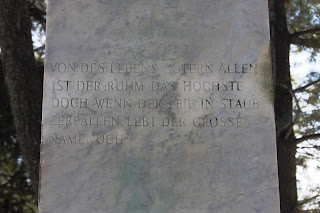The Bronco Buster, first copyrighted in 1895, is probably Remington's most recognizable sculpture:

Hundreds of authorized casts and untold numbers of unauthorized casts of the exist; the one above, cast in 1918, is from the collection of the Metropolitan Museum of Art. One of the most famous individual Bronco Buster casts, though, and one of the best for eagle-eyed TV and movie viewers, is the cast that belongs to the White House collection. Given as a gift during the Carter administration, the sculpture resides in the Oval Office, and is thus constantly working its way into the frame, both with real-life presidents and with fictional presidents.
Real president:

Fake president:

Oh, and then there was this one time when I was in this weird store at Caesar's in Vegas, and they had a Bronco Buster that was about eight feet tall, and it was for sale!

Not really sure who the intended audience for this thing is, or who might buy it, but I thought it might be worth bringing up in a post about Remington.
But where was I? Weren't we talking about the Coen Brothers?
I noticed a few years ago that bronze sculptures and other works of art tend to show up in the background in Coen Brothers films A LOT. There are a lot of examples, but today I'm going to focus on two that feature Remington, one from Fargo and the other from Burn After Reading. Interestingly, both of these scenes feature characters who decide to pull the rug out from under close family members.
The first is Fargo. William H. Macy's hapless car salesman arrives at a meeting with his much wealthier father-in-law, played by Harve Presnell. Macy is looking for a loan for a real estate deal, but as the conversation progresses, it becomes clear that the father-in-law has no intention of lending the money, that he holds nothing but barely veiled contempt for his son-in-law, and that furthermore, he plans to cut Macy out of the deal entirely and use his money to fund the purchase for himself. And meanwhile, Remington's Bronco Buster and Cheyenne (copyright 1901) look on:

If you've seen Fargo, you know that this conversation, spurred by Macy's desperate search for money, begins a devastating chain of events that results in several deaths.
Remington's Cheyenne (the same cast perhaps?) witnesses another scene of familial cruelty in Burn After Reading:

This time, the sculpture resides in the office of Katie Cox's (Tilda Swinton) lawyer. During the scene in question, she negotiates with her lawyer to bring divorce proceedings against her husband, played by John Malkovich. Not only is the divorce a complete surprise to her husband, but she accompanies the announcement by freezing his assets and changing the locks on their Washington, DC townhouse. As in Fargo, this action sets off a desperate chain of events, this time played for broadly comic effect.
So what does this say about the Coens' opinion of people who own and display Remington sculptures? I'm almost afraid to speculate.
Personal note: Once again, I'm realizing that other responsibilities are keeping me away from blogging as much as I'd like. I'm going to keep posting as much as possible in the next six weeks, but look for much more regular posts after September 1! I'm going to be relocating to DC in September, and I'm hoping I'll get a lot of new inspirations for blogging in that environment.




































